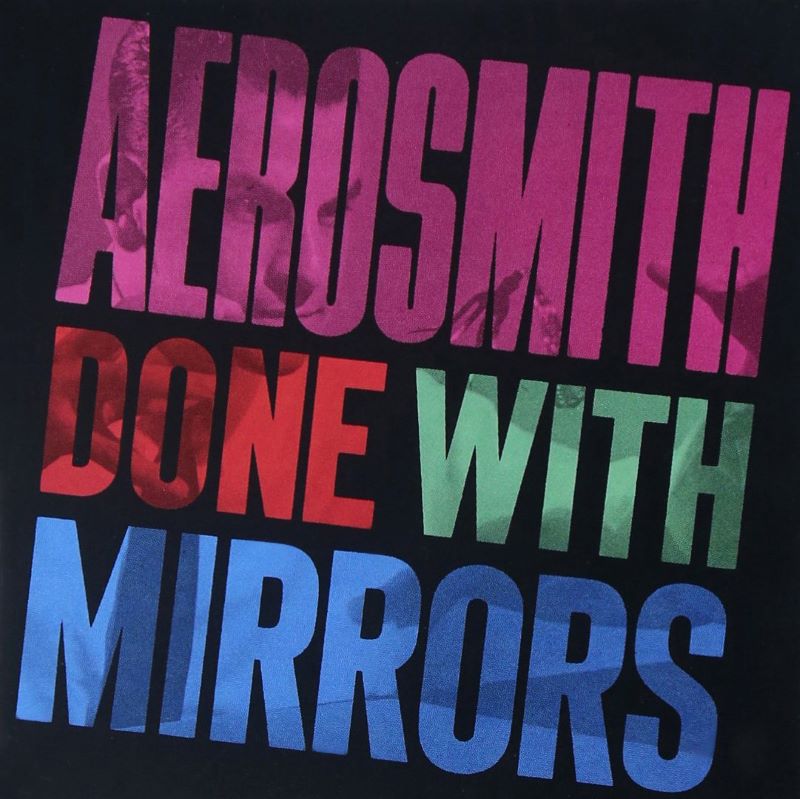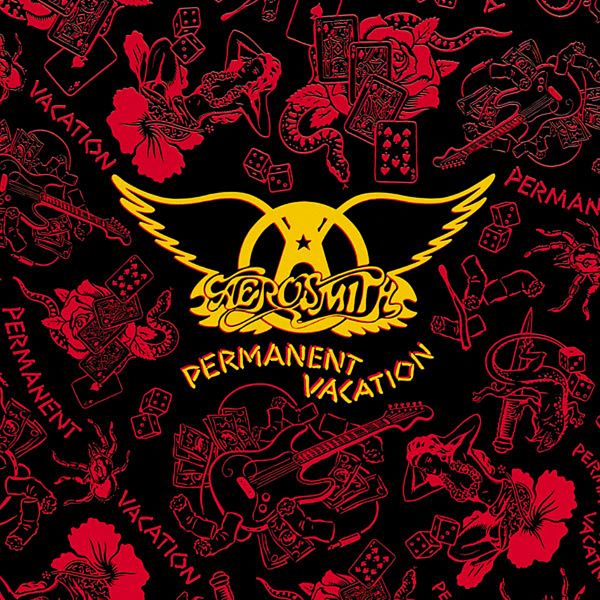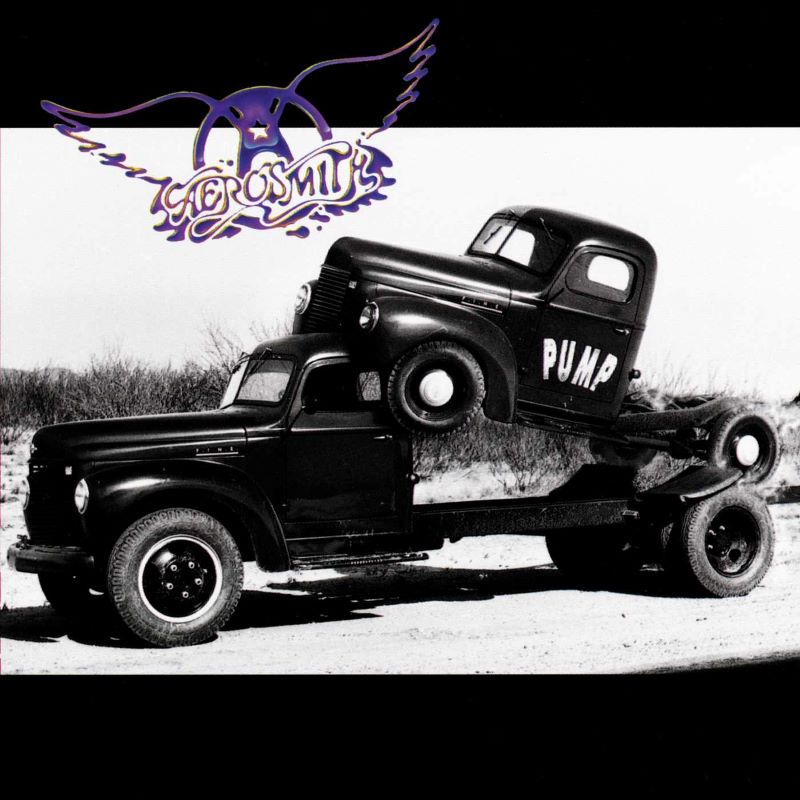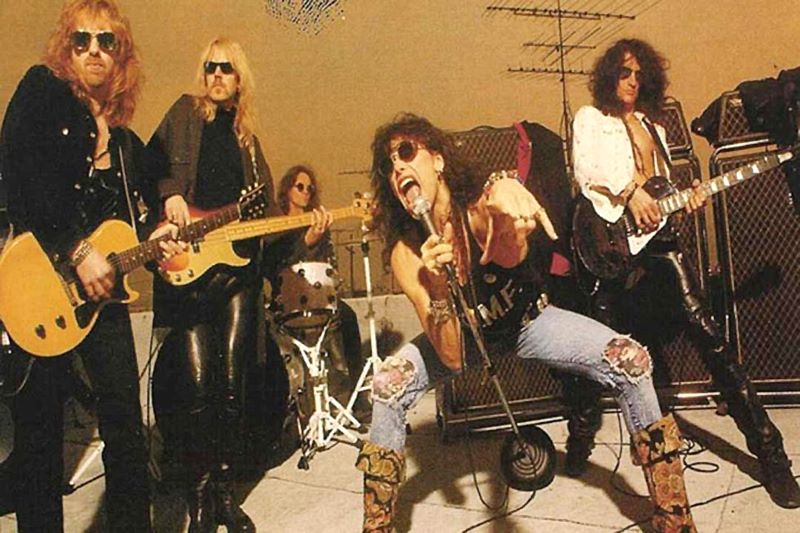THE SECOND PART OF BIOGRAPHY AND DISCOGRAPHY IN YEARS (1984-1994).
THE ARTICLE IS ALSO AVAILABLE IN DIGITAL FORM (20 PAGES) AND IS ENRICHED WITH LOTS OF BEAUTIFUL PHOTOS. TO VIEW IT, CLICK ON THE BUTTON LOCATED BELOW.

H I S T O R Y
1984–1986
The absence of Joe Perry in the band was so daunting for Steven Tyler that it wasn’t possible for the band to get him to work on the next album. Guitarist Jimmy Crespo commented on the situation at the time that he listened over and over to how Joe did this, or Joe did that. He accepted the situation and, in his words, the only solution for AEROSMITH was for Joe and Brad to return. The reunion of the original line[1]up took place in the spring of 1984. The mutual follow up was not as easy as everyone would most likely have wished. Joe Perry was very skeptical at first. Joe and Steven were exactly in the same phase; they were both broken. Joe Perry struggled with a decline in solo album sales and the consequences of a wild divorce. So, in the end, with the hope for a better future, he agreed to return to the band. However, legal issues still had to be resolved. Joe Perry was represented at that time by manager Tim Collins. Joe was also suing the previous management of AEROSMITH – Leber-Krebs for neglect of commitment towards the band. In addition, he refused to continue working with management. So, if AEROSMITH wanted Joe Perry back, there was no other option except to quit the contract with Leber-Krebs to end their cooperation and move under the wing of Tim Collins. The same situation soon awaited the band regarding the change of label. The termination of the contract with Columbia Records, to which AEROSMITH were still obligated, was accompanied by further struggles and trials. Without the label and with the new management, there was nothing else to do but to go on another tour and repeat the same scenario as in the 1970s. From June to August 1984, AEROSMITH made a total of 70 stops in the United States and confirmed their success from the 1970s. By restoring the original line-up, they attracted a lot of their devoted fans. One of the most important representatives of Geffen Records, John Kalodner, literally saved the band. Despite their ongoing drug addiction, he considered them one of the best American rock bands. He felt enormous potential in them, despite all who had buried them. Convinced that they could achieve much more than ever before, he offered the band a contract. The next logical step was the release of a new album.
Talented Ted Templeman took on the role of producer. AEROSMITH hired him shortly after hearing his statement at the Grammy Awards that he would like to work with the band. He became famous for his production duties with VAN HALEN, so the band was sure he understood hard rock sound well. The recording took place at Fantasy Studios in Berkeley, California, with additional tasks performed in Power Station Studio in New York. Cooperation with Ted went well and quickly. They recorded one song per day. Templeman‘s intention was to achieve the sound of live concerts. And so, he often recorded the band when the musicians weren’t even aware what was going on. Moreover, they were still unsuccessfully fighting their biggest demon, drugs. They tried hard, but once they got home for the weekend, they couldn‘t resist the temptation.

’“Done with Mirrors” is that old expression used to explain success. You know, when a magician saws a lady in half or pulls a rabbit out of a hat, the cynics always sum it up by saying: ”It’s all done with mirrors.” Well, a lot of sceptics also followed AEROSMITH around, and whenever we did something right, they’d ask us how we did it. Now we tell them it’s all done with mirrors. We’re through explaining ourselves.’
(STEVEN TYLER)
The album “Done with Mirrors“ was released on the 21st of October 1985. Steven Tyler explained the meaning of the title: ’“Done with Mirrors” is that old expression used to explain success. You know, when a magician saws a lady in half or pulls a rabbit out of a hat, the cynics always sum it up by saying: ”It’s all done with mirrors.” Well, a lot of sceptics also followed AEROSMITH around, and whenever we did something right, they’d ask us how we did it. Now we tell them it’s all done with mirrors. We’re through explaining ourselves.’
Despite all the effort and flavor embedded in the recording, the album unfortunately does not achieve greater commercial success and, in reviews, is more likely to receive average rating. Critics blame the band for lacking the spark and power of their previous era. To date, however, the concert set does not lack the strongest piece of this album, which undoubtedly is the song written by Joe Perry before leaving the band back in 1979, “Let the Music Do the Talking“. Overall, the album is not weak and definitely offers some distinctive AEROSMITH great songs as for example “My Fist Your Face”, “Shame on You”, “Gypsy Boots” or “She’s on Fire”. It is just a pity it did not reach the expectations and hopes put on it. Despite the efforts of producer Ted Templeman, the final result was far from what has been achieved on the albums “Toys in the Attic” and “Rocks”. The situation was not saved by the cover of the album either, which lacks the idea or at least the famous winged logo of the band. AEROSMITH are disappointed by the lukewarm reactions they receive after the album release. After their comeback, it is necessary to learn from the first unsuccessful lesson and bet on a card that will finally bear fruit.
The year of 1986 is written in the history of AEROSMITH as a year of fundamental and much needed breakthrough. Musicians are more clearly aware of how harmful drugs are to them in every way, and above all that they block their creativity. They decide to undergo treatment and enter the Caron Foundation treatment center in Pennsylvania. There they undergo a demanding cessation process and persevere with 12 program levels they have to manage to complete. After the treatment, they are drained, but sober for the first time in ten years. At the same time, Rick Rubin, producer and big fan of AEROSMITH, comes up with a priceless idea. At his instigation, the rapper Run DMC is supposed to do the cover version of one of the greatest AEROSMITH classics, the song “Walk This Way“. The hope is that this crossover will break down barriers and achieve the crossover success in the States they needed. Steven Tyler and Joe Perry are invited to collaborate to give the song the drive that was missing. The cover version is accompanied by Tyler‘s vocal and Perry‘s guitar parts. And that is how a mega hit was born in a new form. Without knowing it, Rick Rubin killed two birds with one stone. Hit scores in the top ten in the US and the UK, and Run DMC gain worldwide popularity. AEROSMITH gain critical youth support, confirming their comeback.
1987–1988
The time has come to silence the skeptics and show the world the true potential of the band. After the disappointment of the previous failure, it was necessary to convince people that AEROSMITH were able to produce the hits they needed to reverse the whole situation. Geffen Records bet on certainty and approached hitmakers such as Desmond Child and Jim Vallance, who have played a major part in the success of BON JOVI, KISS and BRYAN ADAMS. It was the first time in AEROSMITH’s career that someone else had been involved in the songwriting process on the album other than the band members. The recording of the album “Permanent Vacation” began in February 1987. As a producer, Rick Rubin initially played with the band. Due to his tough schedule however, he did not manage to finish the album with them. In collaboration with Rick, they recorded six demo recordings, including “Love Me Like A Bird-Dog”, which in the end didn’t appear on the record. He was replaced by renowned producer Bruce Fairbairn, an internationally successful and acclaimed Canadian who is considered one of the best producers of the entire era (active in 1976– 1999). It was a step in the right direction which was worthy of the band. AEROSMITH continued recording their new album at Little Mountain Sound Studios in Vancouver. They composed a total of 28 songs, of which 12 were selected for the final release of the album.

“Permanent Vacation” is released on August 18, 1987 and is a turning point in their career. From the day the album appears in the stores, it has received ovations from fans and music critics alike. The popularity of AEROSMITH is skyrocketing and the number of devoted fans who have been with the band since the beginning of their careers has expanded considerably. The album becomes platinum a few weeks after its release. The three hits “Angel”, “Rug Doll” and “Dude Looks Like A Lady” break down the charts, and the band have the door wide open at the MTV music station, which puts all three videoclips into the broadcast. AEROSMITH builds on the success of “Toys in the Attic” and “Rocks”, their most successful 1970s albums. The overall atmosphere of the album literally confirms the resurrection and release from the worst drug madness of musicians. The album is packed with positive emotions, vitality and an appropriate dose of humor and perspective, as evidenced mainly by the song “Dude Looks Like A Lady”. Steven Tyler was inspired by the meeting with MÖTLEY CRÜE in New York. When the band members were talking, it was all about Dude here, Dude there. Everything was called Dude. Then they sat down in the bar together with the singer Vince Neil, and Steven watched all the waiters dressed as women. And that is how he came up with the idea for “Dude Looks Like A Lady”. AEROSMITH on the album honors their idols THE BEATLES in the form of the only cover version of “I’m Down”, which originally appeared on the B-side of the single “Help“ from 1965. After the song “Come Together”, it is their second commercially successful cover version by THE BEATLES. AEROSMITH did not forget their blues roots, which they return to in the song “Hangman Jury“. The song tells the story of a singer whose wife constantly attacks him because of lack of money. One day, he returns home completely drunk. He points a gun at her and shoots her. Only after he pulls the trigger does he realize that the gun was indeed loaded. In court, no one trusts his version, and he does not deny that she finally got what she deserved. Because she was a prostitute and refused sex with her husband. He is sentenced to death by hanging and the story ends with a fatal morning when his execution is about to take place. AEROSMITH boldly ventured and enriched their blues-hard rock roots with pop. This, of course, fits perfectly into the atmosphere of the mid-1980s. At the same time, it is a period that has divided the band‘s fans into three camps: the 70s era fans, the followers of AEROSMITH since the “Permanent Vacation” release, and the third group are fans who support the entire band catalogue or choose what they like the most from each period. “Permanent Vacation“ is also the first chapter of three commercially successful AEROSMITH albums. Shortly after the release of the album, Steven Tyler and Joe Perry set out for Europe to attend a promo tour, provide interviews and attend press conferences. On the promo tour, they discover that they are actually presenting AEROSMITH as a completely new band in Europe, where they have never achieved more commercial success before. Steven spoke openly about drug addiction and that he hadn‘t touched alcohol and drugs at that time for a year. In October 1987, AEROSMITH headed on the biggest tour up to that time, with 160 stops and lasting until the end of the summer of 1988. It was divided into three parts. The band was strictly kept from alcohol and drugs. They were not allowed to drink, neither their crew nor the opening bands which were DOKKEN and WHITE LION. On the last part of the tour they met together with GUNS N‘ROSES and for the first time they mutually shared the stage. AEROSMITH were their essential musical influences. The “Permanent Vacation” album and tour were a huge success for the band. In the United States, it sold 5 million copies. This is the first AEROSMITH album that also scored in the charts in England and won a gold and silver album for its sales there.
1989–1990
AEROSMITH, excited by the success of the last album and aware of something big in the air, started working on the next album two months after the “Permanent Vacation” tour ended. Now it is more than ever necessary to keep the set standard. The proven duo Desmond Child and Jim Vallance have been invited to cooperate again. The first song that Steven Tyler and Joe Perry wrote together on “Pump” (a credit for the album’s name is attributed to guitarist Brad Whitford) was “Monkey on My Back”. The song is about the adventures that musicians experienced under the influence of chemistry in the body. After a successful collaboration with producer Brian Fairbairn, who had a major impact on the success of the previous album, there was no reason for a change. In March 1989, AEROSMITH went to Little Mountain Sound Studios in Vancouver again. At the same time, MÖTLEY CRÜE were recording right next door and were working on their upcoming album “Dr Feelgood”. If this situation had occurred a few years earlier, maybe some members of both bands wouldn’t still be alive. This time, both parties met at a time when everyone was sober and eager for great success. Steven Tyler even joined MÖTLEY CRÜE and recorded vocals on “Sweet Sticky” (along with Bryan Adams) and on the “Slice of Your Pie” intro. Fortunately, the dreaded return to the old bad habits did not happen, so everything went well, and both bands recorded at the same time albums which are considered one of the best and the most successful in their discographies. Bassist Tom Hamilton said in one interview that for him the recording period of the “Pump” album was the first to be completely clean after years. While recording “Permanent Vacation” he didn’t drink anymore, but he smoked a bowl of pot every day. He was the last member of the band to get it. He got sick of being paranoid, of being the only one out there. The recording period of “Pump” also meant for Tom a re-exploring the bass technique. He spent a lot of time practicing and listening to the great influences like John Paul Jones of LED ZEPPELIN or the bassist of legendary MOTOWN, James Jamerson. There was a promise they had made together with drummer Joey Kramer many times before, and now they finally did it. Together they worked a lot on the grooves of all the songs so that the final sound was the best possible. Joey adds that this time nobody can blame him for overplaying on this album, because he tried to make things as simple as possible and concentrated mainly on making the grooves work.

AEROSMITH met the owner of a local bizarre toy store, Randy Raine Reusch, while recording “Pump”. Steven Tyler recalls that the store was full of hundreds, if not thousands, of instruments made of bamboo and even human femurs. Enthusiastic about the other-worldly sounds that the various instruments made, they came up with the idea of introducing them on their album and incorporating a less commercial aspect into the final sound in response to some criticism of “Permanent Vacation”. They convinced Randy to allow them to jam with these instruments and eventually used them as an interlude to tie the whole album together. In addition to selected sounds, they added African ritual music, borrowed from Izzy Stradlin from GUNS N’ROSES and a water phone from the band’s friend. These interludes have become the backbone of the album “Pump“, which evokes a specific atmosphere. AEROSMITH symbolically connects rock with the music and culture of native Americans. The album “Pump” was released on September 12, 1989 and became platinum. In the US charts there were three songs in the selection of the best TOP 10 songs including “What It Takes” and “Love in an Elevator”, which finally broke the ice on the European market and scored in the charts there. For the first time in its history, AEROSMITH has won the prestigious Grammy Award for “Janie’s Got A Gun“. Joey Kramer adds: ’The song “Janie’s Got A Gun” means a lot to me. Steven has hit upon a subject that most people were afraid to deal with and even unaware of – parental abuse and violence against their children.’ Steven Tyler dedicated the lyrics to the topic of abuse in America and tells the story of a girl raped by her father. It‘s about incest, which happens to a lot of kids, who don’t even find out about it until they find themselves trying to work through some neuroses. The video was directed by movie director David Fincher (director of the sci-fi trilogy “Aliens“). AEROSMITH embarks on a worldwide tour in the fall of 1989 shortly after the release of the album “Pump“. The tour started in Germany and lasted eighteen months.
’The song “Janie’s Got A Gun” means a lot to me. Steven has hit upon a subject that most people were afraid to deal with and even unaware of – parental abuse and violence against their children.’
(JOEY KRAMER)
1991–1994
Expectations were enormous and the band was under even more pressure than they were with the previous two releases they had achieved great success with. In the beginning of 1991, AEROSMITH began working on their next studio album. Over the period of two months, they had recorded many tracks on the tape, including “Amazing” and “Eat the Rich”, which was supposed to become the title track of the album. Initially, they recorded in Los Angeles, A&M Studios. But the songs lacked the dynamics and energy evident from both predecessors. Steven Tyler recalls that when they listened to the recordings, they weren’t sure if they were as adequate a follow-up to “Pump” as they wished. The question was not whether the songs were good enough. The question was whether they had enough time to do them better, and in the end, decided to make the time to work on the album. This time, they decided to continue in Boneyard, Joe Perry’s home studio, where most of the ideas for the album originated. It was definitely worth the effort for the band to give it more time and space. Third time lucky. So the production was again in the hands of the experienced Brian Fairbairn, and the album was also recorded at Little Sound Studios in Vancouver. This is the last collaboration of AEROSMITH with the producer, who significantly influenced the sound and direction of the band in their new era and played a big role in their success. It is also the last album released under the wings of Geffen Records before AEROSMITH returns to Columbia Records.
Before the fans got the next studio album, a rare “Pandora’s Box” was released by Columbia Records to make the waiting shorter. It was released in 1991 and definitely pleased every loyal AEROSMITH fan. It consisted of a 3-CD box containing 54 recordings including previously unreleased rarities with a 64-page booklet full of rare photos and information. “Pandora’s Box” maps the band’s era from their beginnings in 1982, until the release of “Rock in A Hard Place”. The archive is also enriched with recordings from the solo albums of Joe Perry and Brad Whitford and from the period of Steven Tyler in THE CHAIN REACTION. There is also a cover version from THE BEATLES – “Helter Skelter”, recorded by AEROSMITH in 1975.

The final version of “Get a Grip” was ready in the winter of 1992 and was released on April 20, 1993. Despite of all the opinions of skeptics and those who do not support this album and consider it significantly weaker than “Permanent Vacation” and “Pump”, for AEROSMITH, it is considered as the best-selling album worldwide in their history (20 million copies). The era of giant video productions was slowly coming to its end, and the glory of the MTV music station was no longer as prominent as in the second half of the 1980s. AEROSMITH belongs to one of the few bands that are not influenced by rising grunge popularity in the early 1990s. At a time when a lot of artists on the rock scene were losing their contracts with record labels, AEROSMITH broke record sales and concert attendance. Young audiences were going crazy while watching videos that AEROSMITH supplied us with abundantly. The album “Get A Grip” is literally a hit factory, and AEROSMITH comes with a ballad collection in their own original approach in which they have no competition. Never before or after has anyone done anything like the thrilling “Crying”, “Crazy” or “Amazing”. The collection of video clips is a symbol of the era in which they were created, and simultaneously, has a kind of timelessness and mood that has its own meaning even in a time when such videos have not been produced for years.
AEROSMITH focused on American youth, and not only America lay at their feet. They sent the whole world the American dream that most of their fans wanted to live. The prototype of trendy girls and boys were involved in their videoclips. Every girl wanted to dress and look like Alicia Silverstone or Liv Tyler at the time, and all the boys dreamt of exactly their kind of women. Alicia and Liv played together in the “Crazy” videoclip. For Liv Tyler, the engagement in this video was her clip debut. And if anyone would think her famous father, AEROSMITH’s front man, Steven Tyler was the one behind her appearance in the video, they would be completely wrong. The idea was put forward by the video creators after seeing Liv in a Pantene commercial. For Alicia Silverstone, it was the third AEROSMITH video she featured in; “Crying”, “Amazing” and “Crazy” – the best clip trilogy in rock history of all time. As in the case of the two previous albums, several names appeared on “Get A Grip” who, together with the band members, contributed to the songwriting process. Desmond Child and Jim Vallance were again on the board, but this time also Mark Hudson, Richie Vulture, Taylor Rhodes, Jack Blades, and Tommy Shaw were also added to the line-up. Richie Supa is a longtime friend of the band who also used to be Steven Tyler‘s heroin connection back then, and everyone around tried to keep them as far apart as possible. He also helped the band when Joe Perry left by filling in for Joe until they found a new replacement. Richie was now clean for four years, and Steven wanted the two of them to write a song together. Not surprisingly, their mutual cooperation resulted in the song “Amazing” which is about the troubled life of drug abuse. The album also featured two special guests who helped out with backing vocals. Don Henley (founding member of THE EAGLES) in “Living on the Edge“ and Lenny Kravitz in “Line Up“. Joe Perry featured in one of his solo compositions and also as a singer in the song “Walk on Down“. Its lyrics are darker, as is the case with the songs “Fever“ and “Get A Grip“. They are about the problems the band was dealing with in the past. For “Crazy“ and “Living on the Edge“, AEROSMITH won two Grammy awards for the best rock performance by a duo or group with vocal. In June 1993, AEROSMITH began a worldwide tour that lasted until the end of 1994 and played a total of 225 shows. AEROSMITH performed for the first time in the countries of Eastern Europe and in the countries of South America.

In March 1994, the drummer Joey Kramer receives a message about his father‘s death. Sad news that hit him when they were right in the middle of the tour. However, the band members drew close together and showed their support and solidarity with Joey. They all attended his father’s funeral together. in all magazines around the world. There is probably no radio or television station that would not have broadcast their songs at that time. The girls are going crazy and are willing to do anything to touch or be kissed by Steven Tyler. Crowds of fans are waiting for the band everywhere they appear, at the airport, in front of their hotel rooms, behind the scenes of the concert halls. The security guards have the biggest job at the shows. The eager girls skip the barriers trying to reach their idols, constantly throwing out their underwear of diverse sizes and colors. Many Hollywood stars and music colleagues attend their concerts as well. The band collects one prize after another. In addition to two Grammy Awards, they win the MTV Music Award for the Best Video of the Year 1994 for the “Crying” video. The award is given to them by the Queen of Pop, Madonna herself.
Before AEROSMITH can move on and start working on the next album to be released by Columbia / Sony, it is still necessary to comply with the contractual commitment with the previous label. In November 1994, Geffen Records released the biggest hits compilation, which maps the ten-year era of AEROSMITH at Geffen Records. The biggest hits collection is called “Big Ones” and also includes the newly recorded songs “Blind Man”, “Deuces Are Wild” and “Walk on Water”. The tracks were recorded during the “Get a Grip” tour in New York and the Isle of Capri in Italy. The audio version of the album is complemented by a collection of 9 video clips that were also created during the Geffen Records era and were released under the title “Big Ones You Can Look At”. This definitively closes the period of mutual ten-year cooperation, and AEROSMITH awaits the fulfillment of their further commitment in the form of their already twelfth studio album.
